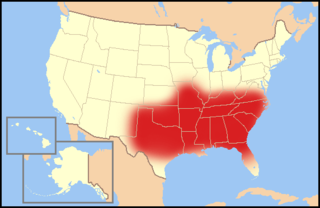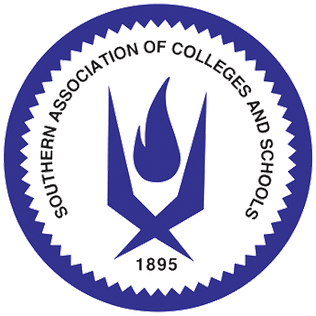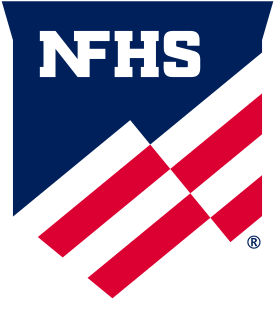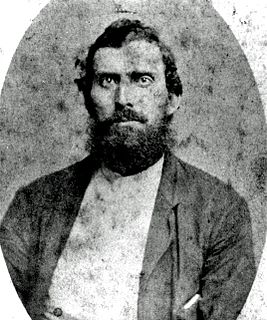The Southern Interscholastic Press Association (SIPA) is a nonprofit organization whose purpose is to promote journalistic professionalism by public schools in the Southeast of the United States of America. The association was founded in 1926 at Washington and Lee University and moved to the University of South Carolina in 1972. Members of the association come from the states of Alabama, Arkansas, District of Columbia, Florida, Georgia, Kentucky, Louisiana, Maryland, Mississippi, North Carolina, Oklahoma, South Carolina, Tennessee, Texas, Virginia, and West Virginia.

The Confederate States of America (CSA), commonly referred to as the Confederate States or the Confederacy, was an unrecognized breakaway state that existed from February 8, 1861, to May 9, 1865, and that fought against the United States of America during the American Civil War. Eleven states with declarations of secession from the Union formed the main part of the CSA. They were South Carolina, Mississippi, Florida, Alabama, Georgia, Louisiana, Texas, Virginia, Arkansas, Tennessee, and North Carolina. Kentucky and Missouri also had declarations of secession and full representation in the Confederate Congress during their Union army occupation.

The cuisine of the traditionally-defined Southern United States encompasses diverse food traditions of several regions, including Tidewater, Appalachian, Lowcountry, Cajun, Creole, and Floribbean cuisine. In recent history, elements of Southern cuisine have spread to other parts the United States, influencing other types of American cuisine.

The United Daughters of the Confederacy (UDC) is an American hereditary association of women engaging in the commemoration of Confederate Civil War soldiers, the funding of monuments to them, and the promotion of the pseudo-historical Lost Cause ideology and white supremacy. It was established in 1894 in Nashville, Tennessee. In the early 1900s the organization often applauded the Ku Klux Klan and funded the building of a monument to the Klan in 1926. The UDC has been labeled as neo-Confederate by the Southern Poverty Law Center.

The Southern United States, also referred to as the Southern States, American South or simply the South, is a geographic and cultural region of the United States. It is between the Atlantic Ocean and the Western United States, with the Midwestern United States and Northeastern United States to its north and the Gulf of Mexico and Mexico to its south. It also has major portions that are part of the Eastern United States.

The Bible Belt is a region of the Southern United States in which socially conservative Christianity plays a strong role in society and politics, and church attendance across the denominations is generally higher than the nation's average. The region contrasts with the religiously diverse Midwest and Great Lakes, and the Mormon Corridor in Utah and southern Idaho.

Appalachia is a cultural region in the Eastern United States that stretches from the Southern Tier of New York State to northern Alabama and Georgia. While the Appalachian Mountains stretch from Belle Isle in Canada to Cheaha Mountain in Alabama, Appalachia typically refers only to the cultural region of the central and southern portions of the range, from the Blue Ridge Mountains of Virginia southwest to the Great Smoky Mountains. As of the 2010 United States Census, the region was home to approximately 25 million people.
The southeastern United States, also referred to as the American Southeast or simply the Southeast, is broadly the eastern portion of the southern United States and the southern portion of the eastern United States. It comprises at least a core of states on the lower East Coast of the United States and eastern Gulf Coast. Expansively, it includes everything south of the Mason–Dixon line, the Ohio River, the 36°30' parallel, and stretches far west as Arkansas and Louisiana. There is no official U.S. government definition of the region, though various agencies and departments use different definitions.
Southern Democrats are members of the U.S. Democratic Party who reside in the Southern United States.
The Declaration of Constitutional Principles was a document written in February and March 1956, during the 84th United States Congress, in opposition to racial integration of public places. The manifesto was signed by 19 US Senators and 82 Representatives from the South. The signatories included the entire Congressional delegations from Alabama, Arkansas, Georgia, Louisiana, Mississippi, South Carolina, and Virginia, most of the members from Florida and North Carolina, and several members from Tennessee and Texas. All of them were from former Confederate states. 99 were Democrats; two were Republicans.

The Southern Association of Colleges and Schools (SACS) is an educational accreditor recognized by the United States Department of Education and the Council for Higher Education Accreditation. This agency accredits over 13,000 public and private educational institutions ranging from preschool to college level in the Southern United States. Its headquarters are in North Druid Hills, Georgia, near Decatur, in the Atlanta metropolitan area.

The National Federation of State High School Associations (NFHS) is the body that writes the rules of competition for most high school sports and activities in the United States. NFHS's headquarters are located in White River State Park in Indianapolis, Indiana.
The history of the Southern United States spans back hundreds of years, and includes the Mississippian people, well known for their mound building cultures. European history in the region began in the very earliest days of the exploration and colonization of North America. Spain, France, and England eventually explored and claimed parts of what is now the Southern United States, and the cultural influences of each can still be seen in the region today. In the centuries since, the history of the Southern United States has recorded a large number of important events, including the American Revolution, the American Civil War, the ending of slavery in the U.S., and the American Civil Rights Movement.

The Southern Railway was a class 1 railroad based in the Southern United States between 1894 and 1982, when it merged with the Norfolk & Western to form Norfolk Southern. The railroad was the product of nearly 150 predecessor lines that were combined, reorganized and recombined beginning in the 1830s, formally becoming the Southern Railway in 1894.

Francis Butler Simkins was a historian and president of the Southern Historical Association. He is best known for his highly praised history of the Reconstruction Era in South Carolina, that gave fair coverage to all sides, and for his widely used textbook The South, Old and New (1947) and his monographs on South Carolina history. A colorful if eccentric professor at Longwood College in Virginia, Simpkins was a leading progressive in the 1920s and 1930s regarding race relations, but became more conservative in the 1950s and 1960s, in part because his wife taught nearby in the Prince Edward County, Virginia public schools, which became a companion case to Brown v. Board of Education and thus a touchpoint of Massive Resistance.

The Upland South or Upper South is a cultural and geographic subregion in the inland part of the Southern and lower Midwestern states. It differs from the Deep South and Atlantic coastal plain areas in terms of terrain, histories, economics, demographics, and settlement patterns.
The American Civil War bibliography comprises books that deal in large part with the American Civil War. There are over 60,000 books on the war, with more appearing each month. Authors James Lincoln Collier and Christopher Collier stated in 2012, "No event in American history has been so thoroughly studied, not merely by historians, but by tens of thousands of other Americans who have made the war their hobby. Perhaps a hundred thousand books have been published about the Civil War."

In the United States, Southern Unionists were white Southerners living in the Confederate States of America opposed to secession. Many fought for the Union during the Civil War. These people are also referred to as Southern Loyalists, Union Loyalists, or Lincoln's Loyalists. Pro-Confederates in the South derided them as Tories. During Reconstruction, these terms were replaced by “scalawag”, which covered all Southern whites who supported the Republican Party.
The South Atlantic Intercollegiate Athletic Association (SAIAA) was an intercollegiate athletic conference with its main focus of promoting track and arranging track meets. The SAIAA was first formed in 1911 and remained active until 1921. The conference's membership was centered in the Mid-Atlantic region of the United States, with member schools located in the states of Maryland, Virginia, North Carolina, and South Carolina, as well as the District of Columbia.
The Southeastern Universities Research Association (SURA) is a consortium of 63 universities in the United States and 1 in Canada. Together with Pacific Architects and Engineers (PAE), the Association operates the Thomas Jefferson National Accelerator Facility in Newport News, Virginia. In addition to Jefferson Lab, SURA supports information technology initiatives and coastal and environmental research.